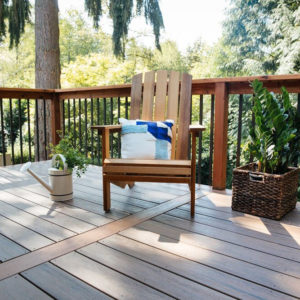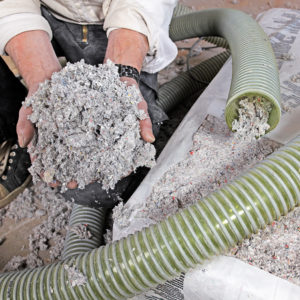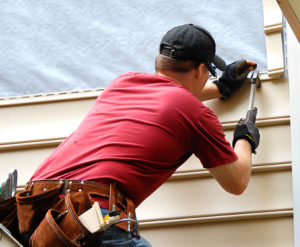Experiencing a roof leak can be a stressful and costly experience if it’s not spotted and taken care of right away. The longer a leak goes on, the more money it will take to repair it. As soon as you detect a roof leak, you should immediately contact a roofing professional to perform a repair and inspection.
If you anticipate rain, snow, high winds, or other weather conditions that could further damage your roof before it can be properly repaired, you may want to take steps to temporarily repair the leak. Of course, we always recommend asking the experts, and Legacy Roofing & Restorations can perform emergency repairs to stop your leak.
The Cost of a Roof Leak
Part of what makes roof leaks both challenging and expensive to repair is that you may not immediately realize you have a leak. A very minor leak might not let in enough water to be noticed, but it can let enough seep in to cause structural damage and mold in your roof over time. That’s why it’s important to have an expert professionally inspect your roof at least once a year.
A larger leak can drip down into other parts of your home or business, causing discoloration and damage to your ceiling, wall, floor, or belongings. If a leak is not addressed quickly, it can lead to a musty odor or the growth of mold and mildew inside your home.
The danger of a roof leak is that it doesn’t just cause damage to your shingles and roofing materials, but to your insulation, electrical wiring, drywall, and anything else that gets in the way. An untended roof leak can quickly add up to thousands of dollars in damages.
Does Homeowners Insurance Cover Roof Leaks?
Every policy is different, so you will want to check with your insurance company to be sure. As a general rule, insurance will cover home roof repairs if the damage is caused by a sudden event such as hail, high winds, or falling tree branches. Homeowners insurance is not likely to cover the cost of roofing repairs if the damage is caused by poor maintenance or age. Also, your insurance company may refuse to pay for the cost of a roof leak repair if you have tried to fix the damage yourself and caused further issues.
How to Find a Leak in a Roof
The first step in repairing a leaking roof is to find the source of the leak. This can be more difficult than it sounds. Water can travel through some materials and then evaporate with only small traces that it was there. While you may be able to spot where the water is ending up, finding where the leak begins can take some work.
Spot the Damage
Water damage can look different depending on the materials. White ceilings or walls will likely show a brown or yellow discoloration. Darker materials or colors might have a pale or smudged-looking section. You can also lightly press on the material to see if it is soft, or if there is any bulging or bubbling.
If you’ve confirmed that there is a leak, you may want to look in your attic or on your roof. Be careful not to step anywhere that a leak might be present. If the leak has been there for some time it may have damaged the structural integrity of your roof, and stepping in the area could damage it further.
Locating the Leak
The first thing to do when looking for a roof leak is to identify damaged sections of your roof. Obvious signs include missing, broken, or upturned shingles. If you have a metal roof you may see rust appearing in a leaking area. One of the best places to start looking for a leak is the punctures and seams on your roof. Satellite dishes, skylights, chimneys, vents, solar panels, or other objects are frequent sources of roof leaks—especially if they have been improperly installed.
If you’re having trouble finding the source of your leak, you can perform a quick test, though it will likely require more than one person. You can try spraying water on your roof with a garden hose to spot the leak while it’s happening. Look for areas where water seems to be pooling, or ask someone to look inside to spot the leak from the ceiling or attic. Obviously, causing more water to leak through your roof can lead to further damage, so only do so if it’s absolutely necessary. If you try this method, spray small amounts of water, and avoid spraying water at high pressure directly at your roof.
As always, we recommend contacting an expert to ensure your leak is properly identified and fixed as soon as possible.
Identifying a Cause
One of the most common causes of roof leaks is severe storms. High winds, hail, or heavy rain can either damage a roof or worsen the damage that is already there. Poorly maintained drainage can also lead to standing water on your roof, which can cause a leak over time. Make sure to properly clean your gutters and eavestroughs at least once a year, especially after heavy storms that may fill them with twigs and leaves. Small animals such as squirrels, mice, raccoons, and insects can also cause damage to your roof. Be sure to look for potential nests or signs that an animal might have chewed through the insulation in your attic.
How to Fix a Leaking Roof
Once the source of a roof leak has been found, you may be able to fix the cause of the leak and put a temporary measure in place to stop further damage until the leak can be properly repaired by a professional.
Clear Potential Blockages
If your leak is caused by poor drainage, you can prevent further water damage by cleaning out your gutters and eavestroughs. However, even if you have stopped further water buildup, the damage caused by the leak may lead to further issues. You should still have the roof professionally inspected to see if any repairs need to be completed.
Complete a Temporary Roof Leak Repair
You may try putting down a waterproof tarp to help cover the leak, but be careful when placing the tarp not to cause any further damage to your roof. You can use duct tape, small nails, or sandbags to keep the tarp in place. Try laying the tarp as flat as possible against your roof to prevent water from coming through at the edges. Even if some water does get through, the tarp can keep out the majority of the water, and prevent rain from falling directly on the leak, temporarily mitigating the issue.
When to Call the Experts
Any time you detect a leak in your roof, it’s best to call the experts. Attempting to fix a leaking roof on your own could lead to your roof’s warranty becoming void. Even if you have managed to stop the leak there may be long-term damage that needs to be remedied. A professional inspection will be able to discover the extent of the damage and show what repairs are potentially needed. The experts at Legacy Roofing will perform a free, at-home inspection and give an estimate on any needed repairs.
Legacy’s Roof Leak Repair Services
Whether you need an inspection, repairs, or a total replacement, the experienced staff at Legacy Roofing & Restorations is here to help with your roofing needs.
Frequently Asked Questions
Do I Need a Roof Repair or Replacement?
That will depend on the extent of the damage and the age of your roof. If the leak has been occurring over a long period of time, parts of your roof may have become rotten, compromising the structural integrity. Even if a replacement isn’t immediately necessary, a roof leak is a good indicator that your roof may need to be replaced sooner or later. Legacy performs high-quality and affordable roof replacements for both residential and commercial buildings using a range of materials.
What Does the Average Roof Repair Cost?
The cost of a roof leak repair will depend on the extent of the damage, the size of the affected area, the location on the roof, and the materials involved. A Legacy employee will be able to give you a detailed breakdown of the cost of a repair during a free, at-home inspection.
Does Legacy Perform Commercial Roof Leak Repairs?
Yes. We work with a wide range of materials, including asphalt, wood, metal, clay, composite, and slate shingles and tiles. We also work with thermoplastic polyolefin (TPO) roofing and ethylene propylene diene monomer (EPDM) when installing commercial roofs.







